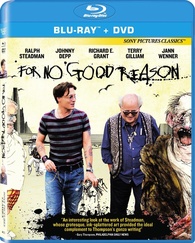 The 2012 documentary For No Good Reason by Charlie Paul explores the life of British cartoon-artist Ralph Steadman, who is best known for caricatures he created alongside the work of his longtime friend, journalist Hunter S. Thompson of Fear and Loathing in Las Vegas fame (or infamy).
The 2012 documentary For No Good Reason by Charlie Paul explores the life of British cartoon-artist Ralph Steadman, who is best known for caricatures he created alongside the work of his longtime friend, journalist Hunter S. Thompson of Fear and Loathing in Las Vegas fame (or infamy).
For No Good Reason was mainly shot on Steadman’s country estate with the artist’s pal Johnny Depp (The Tourist) serving as tour guide and narrator. The film, which incorporates archival footage, personal photographs, selections of the artist’s provocative and entertaining work and animated “updates” of said work, also features contributions from Terry Gilliam (Monty Python), Richard E. Grant (The Iron Lady), Tim Robbins (The Shawshank Redemption) and Jann Wenner (co-founder and publisher of Rolling Stone).
Disc Dish spoke with the lively and candid Mr. Steadman on the eve of For No Good Reason‘s U.S. theatrical premiere in April, 2014.
Disc Dish: What was your reaction when filmmaker Charlie Paul approached you with an interest in making For No Good Reason, a film about your life and work?
Ralph Steadman: At first I thought, ‘Well, that will be alright.’ Remember, Charlie first set out to do it fifteen years ago! So if I was unsure early on in the process, you can see that I came around to the idea later one. When Charlie began coming by my home and studio regularly and I realized he was going to be hanging around all day, I knew it was for real. And he helped me overcome my loneliness. Or I could tell you we made it ‘for no good reason.’ There’s no reason for anything we do, really.
DD: You reveal virtually your entire artistic process in the film, from blank canvass to completed work of art. Was it satisfying for you to pull the curtains back and show audiences how you do what you do?
RS: I’m so trusting and I certainly trusted Charlie. I got into having the camera there, the overhead camera—Charlie set it up for me and we filmed what I was doing. I would be drawing with one hand and clicking the overhead camera with the other hand. The camera was there to show how I did my work and I was happy to show that. For me, it made doing my work feel like playtime. I had a lot of good honest work to do, as well as some “phony” work that I did just for the camera. And I liked it all.
DD: Your adventures and collaborations with Hunter Thompson on the book Fear and Loathing in Las Vegas and other projects are a major part of For No Good Reason, just as they’re a major part of your career and something you will always be identified with.
 RS: I always had a sense of responsibility when I worked with Hunter—I considered it my duty to fulfill my assignments with him, even though Hunter would still be writing when I had finished. Half the time, I never got paid, but working with him was still something to do. And he exposed me to the screaming lifestyle of the U.S. by living it and writing it.
RS: I always had a sense of responsibility when I worked with Hunter—I considered it my duty to fulfill my assignments with him, even though Hunter would still be writing when I had finished. Half the time, I never got paid, but working with him was still something to do. And he exposed me to the screaming lifestyle of the U.S. by living it and writing it.
DD: We’ve all seen actors like Johnny Depp or Bill Murray portraying Hunter, but when we see the vintage clips of him in For No Good Reason, there’s no denying he was a genuine original and occasionally a pretty scary guy.
RS: Oh yes. I did feel a bit threatened by Hunter sometimes. He had a mynah bird, Edward, which he kept in a cage. You’ll see a clip of him in the film. Hunter would bang on the side of the cage and tell Edward he was going to kill him. After a while, I began to identify with Edward!
DD: In addition to your artistry, For No Good Reason delves into your strong sense of justice and human rights.
RS: That’s a very important part of the film and it’s crucial to me. It’s crucial to everyone. Human rights are being violated all the time—we’ve not learned anything over the years. Balloons on sticks, yes, that’s fine. But that’s as far as it should go. We should really cure war, it’s just so stupid. We had that first world war a hundred years and that was supposed to be the war to end all wars. And we haven’t learned. It’s all just rubbish. We should let clowns fight all our wars. There’s great violence in clowning, you know. Or if only they could have those battles with custard pies! That would truly help – it would be like Laurel and Hardy! Remember, there’s no reverse button on a gun
DD: Let’s talk a bit about your relationship with Johnny Depp, whose contributions play a major part of the film.
RS: We go back to the early Nineties, when he was coming to visit Hunter in the years before he made Fear and Loathing in Las Vegas. He was friendly with Kate Moss at that time. Back then, his hair was like a streak down the middle of his face—one eye was
DD: And how did he get involved with For No Good Reason?
RS: He came to visit at one point when Charlie was there with his camera and he just became part of it. And he’s done a bunch of extra bits for the film, as well.
DD: So it was just a coincidence that Charlie was there when Johnny stopped by?
RS: Yes! It wasn’t set up to be so. So he stayed for lunch and the camera rolled. I liked that it wasn’t scheduled.

Hunter S. Thompson’s 1971 novel Fear and Loathing in Las Vegas, gloriously illustrated by Hunter S. Thompson
DD: You appear to approach your art with the same methods that you’ve had since the beginning of your career. What’s your feeling about modern, digital art, much of which was used to animate your art in For No Good Reason?
RS: I always feel that too much art today is done with computer. All work should start with wet ink on paper—it should be external before you shove it into a computer. I don’t mind putting it into a computer and then adding a bucket of paint or adding distortions. It should start with some pre-pencil work, because you’re on a journey, a kind of adventure, and you must see the thing through from beginning to end. But there must be some sense of surprise to yourself. If you end up surprising yourself, then you’re on the right path. When you blot the paper, or spill something on the paper, well, that’s clumsiness. And my thought is to put that clumsiness to good use. There’s a certain style to that and it makes things go a certain way.
DD: I can’t imagine anyone would argue that all art, even the most modern and technological of art, should have a human element to it.
RS: It’s almost as if since Steve Jobs died, computers have taken over our lives. People are walking down the streets talking to each other through their computers on their phones. They’ve got other people right in front of their faces, but they feel that they have to put their fingers to use.
DD: Well, we can thank Steve Jobs a lot for that legacy.
RS: Yes, but if he was here, maybe he could control it more.
|
Buy or Rent For No Good Reason
|
|||
|---|---|---|---|
Blu-ray/DVD Combo |
 Blu-ray/DVD Combo Blu-ray/DVD Combo |
 Blu-ray/DVD Combo Blu-ray/DVD Combo |
|
Leave a Reply